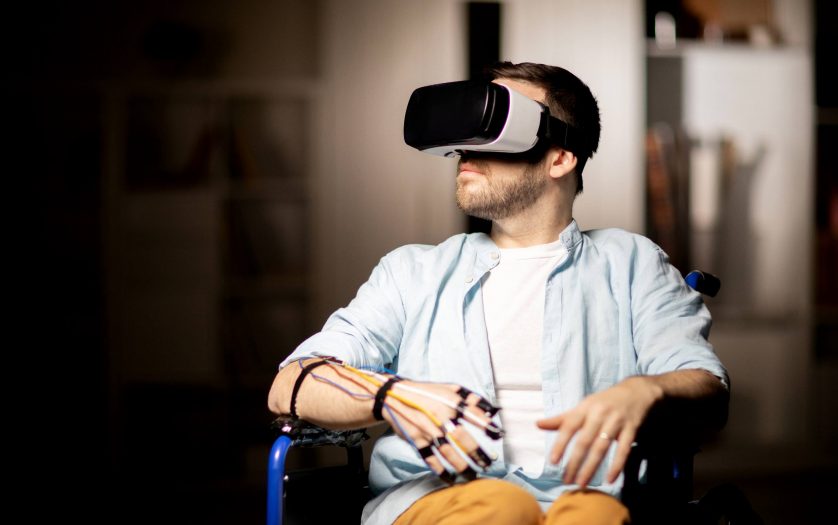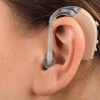How can Virtual Reality technology help persons with disabilities?

“Life is difficult. This is a great truth, one of the greatest truths.” This is the opening line of the book “The less travelled road” from Scott Peck. When I first read this back in my senior year in high school, I felt a great relief in my heart. Sometimes we forget that everyone out is having their own battle.
It was essential for me to embrace and remember myself this fact of my life. A few months apart from that day, my high school friends would each find their professional and personal way in life. On the other hand, I was on the brink of depression because I assumed my disability-related barriers are impossible to overcome.
When I was a little baby, my parents were told that I wouldn’t be able to walk on my own. I was born with a type of muscular dystrophy, which meant I wouldn’t be able to stand up and walk on my own. I’ve gone from one doctor to the other in my life, and I know a lot about this disease, but this is not the point here; therefore, I won’t go into detail. I had a relatively happy childhood, and I owe a lot to my dear parents for this. But as I grew older, I felt different from the rest, and that caused depression. At the end of high school, I had a big mental downgrade to the point I was assigned for a six-month-long anti-depression therapy.
In 2016 quite occasionally, I came across this fancy Virtual Reality video. I was impressed and moved. The technology was officially introduced a few years ago (in 2010, I think), but it was the first time to watch it for me. This first strong impression led me to a few weeks of persistent online research about this technology.
My interest in it intensified, especially when I read about its potential application in helping disabled people like me. I knew that it would do a good world to my mental health, quality of life, and hand to other disabled people facing the same struggles if I helped myself. Then I finally decided to attend a sort of pre-university course in this field to gain a little professional expertise and help afterward.
My goal is to provide other disabled people with relevant information that would help them live, to a great extent, a barrier-free professional and personal life. I want to encourage them to learn about Virtual Reality technology and discover ways how it can help them.
How Can Virtual Reality Help Disabled Students?
Equality is something education must stand for. In our schools, it’s done great progress in this aspect. Anyway, there’s more to be done. Disabled students face still a lot of different problems apart from a customized infrastructure or similar. I know this from my very own experience in school.
So the question is: Can Virtual Reality Technology play a role in tackling this problem? YES, it CAN.
On a major scale and terms, Virtual Reality can provide disabled students with: Customization, Inclusion, Participation.
These are three branches of the same tree, so to say, and they complement each other in this structure.
Customization
Disabled students may have specific needs due to their physical impairments. Let say a student has a partial eyesight loss, and in a normal class setting, a clear vision of the student is essential for him to understand the material. There are VR goggles and additional gears that enable these students to see clearly. This brings us then to the second point.
Participation
When the student knows what is being discussed in the class from our last example, and he/she can engage all his/her senses in the learning process, he/she can participate in discussions. This is an essential element for everyone to excel in school.
Inclusion
It is of great importance for a disabled student to feel part of the learning process. When his/her needs are met, and he/she can participate equally, then, of course, this is easily achieved.
Many classes, especially those held in laboratories, require certain body movements to experiment. I had this problem as a high school student. I would never able to experiment on my own because sometimes I was supposed to be standing on my own feet or move in a certain way, which I couldn’t. So I was only learning about it from what I saw other students were doing. I knew what was going on, but I didn’t felt part of it. I didn’t feel any sense of achievement in a massive turn off for disabled students in career decisions.
VR Technology For Students With Vision Disabilities
Globally the number of people suffering from any sight impairment is growing at a worrying pace. According to the WHO stats, more than 250 million people worldwide have sight problems.
Innovations in VR technology are being used in helping many of them, including those who follow their education dreams.
For example, a London-based startup company developed a few years ago a VR headset that helps people with sight impairments restore their sight almost to normal levels. Essentially what their brilliant innovative device does is that it takes a real-time high-quality image of reality, and then it projects its augmented form to the part of your retina that is still working.
SightPlus is designed in that way so you can adjust it to the level of sight improvement you need through a remote control system.
Even the big company Samsung has built a new VR headset for people with sight issues. Their product is called Relumino. This too is based on the same principles to assist people with sight impairments by making blurry images clearer and by adjusting the contrast of colours accordingly
VR Technology for people using a wheelchair
Mobility is the main problem for wheelchair users. I personally used a wheelchair my whole life, so I learned navigating around way earlier. But some people start using a wheelchair from a certain age because they had an accident or their initial neurovascular or orthopedic disease progressed in time. They find it extremely difficult to move around, and I can understand that. Even worse, in most cases, they have to deal with this problem all alone without any help coming through.
VR technology is already helping these people by simulating a virtual situation where they have to cross a road or navigate in the building of a school. In such a way, the person can learn to move as freely as possible and, more important INDEPENDENTLY.
VR simulations help people undergoing therapies to walk again. What doctors nowadays do is not asking their patients to push themselves to make a few days in each session, but they simulate a walking experience with the help of a VR headset. VR experts claim that this has a strong base in medicine, more specifically neuroscience. They say that a simulated walking experience can trigger a patient’s brain to adapt faster to new motoric skills.
Further on, VR technology can help wheelchair users experience something they could experience otherwise. There are already many VR sets created to simulate a tennis game, go hiking, tour around cities and museums, and so on. And to all these activities, wheelchair users can also have access to thanks to Virtual Reality technology.
Entertainment and VR
Disabled people deal with a lot of mental stress. They need to entertain and feel no barrier to engaging in exciting activities. Here’s where VR technology comes into play.
I, for example, always loved to hike, but I couldn’t because of my wheelchair. In a London workshop, I tried a VR set that simulated walking on stones at the top of the mountain. It felt so real, and I was happy I could experience hiking.
VR is also a perfect opportunity to have fun for people who aren’t disabled. For example, Google offers an outstanding immersive app called Google Expeditions. As you can guess it from the name, it can take on a dreamlike expedition, for example, in Mars.
VR Accessibility for Disabled Students
VR technology is nothing new, but it is still not the norm, so to say. The main problem related to it is certainly its cost. Although they’ve been around for quite a while, their price tag is high, and for many, just another luxurious item they cannot afford. For example, a Virtual reality headset may have a price of up to 1,400 euros, which is surely high for most of us.
There are actually lots of free-to-use VR apps and software, but they’re bounded to a narrow spectrum of disability-related needs. For example, people who have a relatively low level of vision loss may use Chromecast to project something on a TV display to read and see clearly from a certain distance instead of holding a device inches apart from the eye.
Anyway, the day when VR will be accessible for almost all is not too far. Until then, what can disabled people do?
First and foremost, I encourage them to speak up for their specific needs. In school, I didn’t comfortable asking school officials to adjust something in the regular class setting only because I wanted to avoid attracting attention and feeling anxious afterward. That was wrong, and I don’t want others to make this mistake.
Reach out for VR agencies: When I first got to know what potential has this technology to change my life, I checked out for technology groups in my area with VR gears on disposal, and I reached for them. In this way, I had the opportunity to experience VR from close and feeling for real how it could affect my life quality. Eventually, I decided to seek a career path in this area, but I don’t necessarily suggest others like me do the same. I want you to take advantage of this technology and use it to benefit every walk you take in this life.
Future Prospects
Nobody knows for sure what this technology it’s going to provide us with in the future. However, there are strong reasons to be excited about it. Big role players in this industry seem to be firmly determined to widen this technology’s application, especially in medicine. In years to come, we may see doctors who prescribe VR headsets, and this just unbelievable to think about it. The idea of placing yourself in a future situation that feels profoundly immersive has a massive potential to reveal a lot about our reaction mechanisms, which then can help us prepare better for them.
Featured Stories
-
 Beyond awareness – Developmentally disabled people need protection
Beyond awareness – Developmentally disabled people need protection
-
 Limiting the vote for individuals with intellectual disabilities is limiting democracy
Limiting the vote for individuals with intellectual disabilities is limiting democracy
-
 Embracing your identity: Learning to live and thrive with a disability
Embracing your identity: Learning to live and thrive with a disability
-
 I finally got hearing aids at age 26, after a lifetime of feeling stigmatized
I finally got hearing aids at age 26, after a lifetime of feeling stigmatized
-
 Preparing for the parenting life when you have a disability
Preparing for the parenting life when you have a disability

